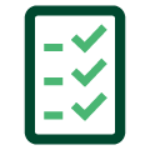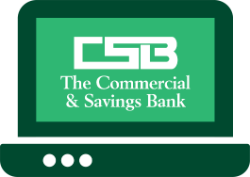
Business Education

- Tab 1Getting Ready to Borrow
- Tab 2Developing a Business Plan
- Tab 3Business Types
- Tab 4Types of Financial Documents
- Tab 5Inventory Management
- Tab 6Additional Resources
 Getting Ready to Borrow
Getting Ready to Borrow
Whether it is the start-up or growth phase, sooner or later most businesses need to borrow money. While every loan process may be different, there are several things you can do to make the loan process easier. Most importantly, remember that loan officers are looking at many things, not just your financial record. Banks lend based on credit and repayment ability not just against collateral.
Consider the Type of Loan
- Have you investigated all the alternative types of capital sources?
- Does the term of the loan you are seeking match up with the purpose for which it is being taken out?
- Does the amount of the loan you are seeking match up with your projected cash flow?
Documentation Needed
- Tax returns – Company and potentially personal tax returns
- Financial statements – Past two years and year-to-date
- Cash flow history and projections
Business Plan
- Do you have an overall business plan and is it current?
- Does it include important information like major customers, suppliers, and key employees?
- Do you have a current marketing plan and are you following it?
Business Practices
- Does your accounting system adequately show the condition and results of the business?
- What is your accounts payable policy? How current are your receivables? Do you take advantage of any discounts for prompt payment?
- What type of insurance coverage do you have? Is there adequate insurance for liability and property damage?
Taxes
- Are all your tax filings current (payroll, property, income)?
- Are your returns prepared by a qualified professional to help you ensure your tax benefits are maximized?
Summary
Applying for a loan can be a stressful experience. The loan officer’s job is to fully understand you and your company and then make the approval decision or present your loan to an approval group. Being prepared can help make the process easier, less stressful, and hopefully improve your chances of getting your loan approved.
At CSB, local experts are ready to help you and your business. Our business bankers take the time to learn about your business make recommendations to help you succeed
We will help you through every step.
 Developing a Business Plan
Developing a Business Plan
Are you ready to start a business? Use these best practices to develop a business plan to help you launch the business of your dreams.
For the business owner who has spent hundreds, if not thousands, of hours thinking about and planning his or her business, it may seem like a waste to spend the time, effort, and energy to develop a formal business plan. But, there is a great deal of difference between pondering business choices and developing a business plan.
There are three important benefits of having a formal business plan. The first is that a business plan will be an essential part of any request for financing. A well-prepared plan improves your chances of obtaining financing. Second, it can serve as a guide for policies and actions for your company over a number of years. Strategies and statements should be well thought out, unambiguous, and capable of being carried out. Third, the process of preparing the plan will enable, if not force, you to focus on issues that are essential for the future success of your business.
A good business plan includes many details. It can take a great deal of time gathering detailed data, interpreting it, and presenting it clearly. For example, while pondering expanding with a new product, it may be OK to target future sales of the product at $3 to $6 million over the next 5 years. For a formal business plan, the range would have to be narrowed considerably and the timing of the sales would have to be estimated for each of the 5 years. Also, expense estimates must be realistic and the plan should include possible contingency plans if the new product sales are slower than expected.
A formal business plan should include the following:
- Company
- History and milestones
- Mission
- Goals
- Objectives
- Company’s products and services
- Major Customers
- Market environment
- Competitive analysis, including competitors
- Risks
- Facilities and offices
- Leases or real estate owned
- Key employees
- Background
- Roles
- Income statements, historical and projected
- Balance sheets, historical and projected
- Cash flow analysis
As you proceed through the business plan, remember that statements should be supported with data whenever possible. Data adds creditability. It is often advisable to use charts and graphs to present the data to make it more easily understood.
Conclusion
The preparation of a full-blown and high-quality formal business plan can be an arduous task. It can take considerable time and force you to address issues that are easy to put off in the daily operation of your business. However, it can be worth the effort.
The process of preparing the plan will put you in a better position to make daily decisions. The final document will be useful when seeking financing, explaining the business to potential key employees, and someday in creating a document for selling the business you worked so hard to create.
Ready to get started?
 Business Types and Documentation
Business Types and Documentation
Sole-Proprietorship
- Schedule C from your personal tax return
- or State certificate of name registration
- or EIN assignment letter
- or Vendor’s license
- Your personal banker will prepare a Sole-proprietor ship resolution
Corporation
- Corporate resolution or Close Corporation agreement
- State certificate of name registration
- EIN assignment letter
- Your personal banker will prepare a corporate resolution and a beneficial ownership certification form
Legal Partnership
- Partnership agreement, including names of partners
- State certificate of name registration
- EIN assignment letter
- Your personal banker will prepare a partnership resolution and a beneficial ownership certification form
Sole Member LLC
- Operating Agreement or other legal document indicating LLC is sole member
- State certificate of name registration
- EIN assignment letter or Social Security Card
- Your personal banker will prepare a partnership resolution and a beneficial ownership certification form
Multiple Member LLC
- Operating agreement, including names of members
- State certificate of name registration
- EIN assignment letter
- Your personal banker will prepare an LLC resolution and a beneficial ownership certification form
Non-Profit Corporation
- Corporate resolution or Close Corporation agreement
- State certificate of name registration indicating nonprofit status
- EIN assignment letter
- Your personal banker will prepare a corporate resolution and a beneficial ownership certification form
Non-Profit Organization
- EIN assignment letter and copy of association’s meeting minutes or letter authorizing signers, listing those authorized on the account and signed by the organization’s persons of authority
- Your personal banker will prepare a resolution of lodge, association, or organization and a beneficial ownership certification form for your control person to sign if the business is registered with the state of Ohio
Clubs & Civic Organizations
- EIN Assignment Letter
- Copy of association’s meeting minutes or letter authorizing signers, listing those authorized on the account and signed by the organization’s persons of authority
- Your personal banker will prepare a resolution of lodge, association, or organization
Beneficial Ownership Certification
What is it?
A Beneficial Owner is:
- Each individual who owns 25% or more of the company
- One individual who has significant managerial responsibility for the company
Required Information for Each Beneficial Owner:
- Name
- Address (Personal or Business)
- Date of Birth
- Social Security Number or Tax Identification Number
- Photo Identification (Driver’s License, State Issued ID Card, Passport, or Alien ID Card)
 Types of Financial Documents
Types of Financial Documents
Balance Sheets
What is it?
Balancing Out:
Why is it important?
A balance sheet is important because it give a quick view of how your business is doing by showing what a business owns (assets) and what it owes (liabilities).
Income Statements
What is it?
Income Statement: Calculating Net Income
Gross Profit
Operating Income
Net Income
Operating income is added to the net non-operating revenues, gains, expenses and losses. This final figure gives the net income or net loss of the business for the reporting period.
Why is it important?
Cash Flow Statement
What is it?
- Operating Activities: Cash earned or spent in the course of regular business activity (ex: selling products or services)
- Investing Activities: Cash earned or spent from investments the company makes (ex: purchasing equipment)
- Financing Activities: Cash earned or spent in the course of financing the company with loans and/or lines of credit
Why is it important?
Inventory Management
What is it?
Why is it important?
Methods of Inventory Management
Just-in-Time Inventory Management
FIFO and LIFO Methods
Kanban is an inventory scheduling system used in lean manufacturing and is designed to keep inventory levels as low as possible. The Kanban system is used to create signals or triggers to reorder and replenish stock in specific quantities. As inventory in a supply closet is used, the quantities are tracked. When it reaches a certain stock level, there will be a signal sent to order more.

 Additional Resources
Additional Resources